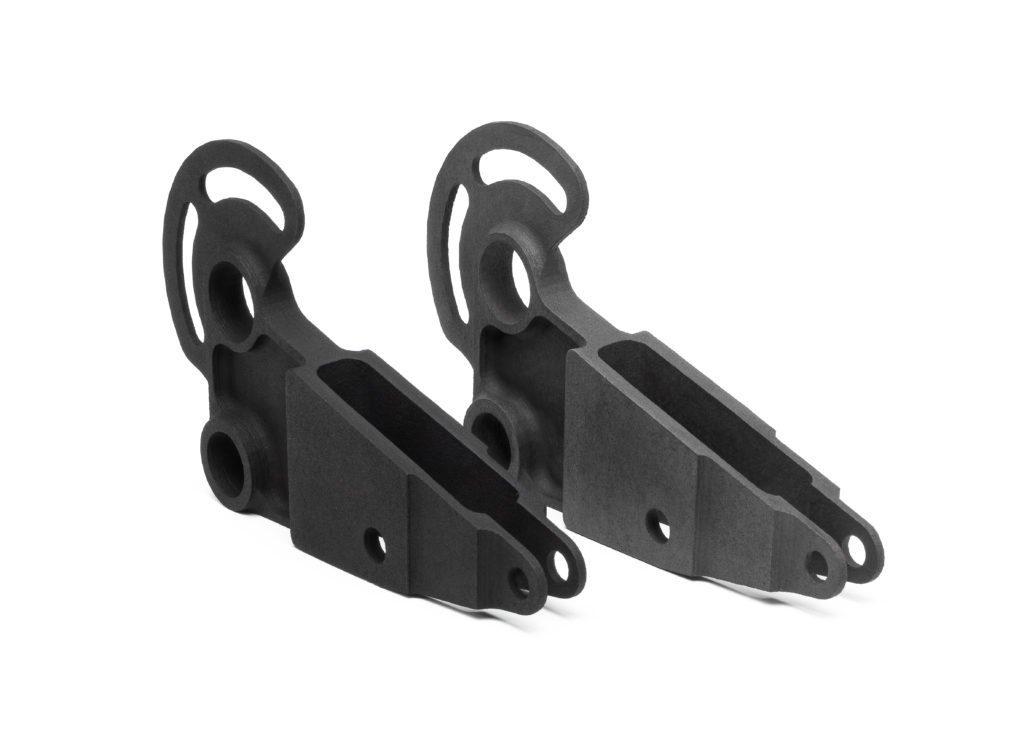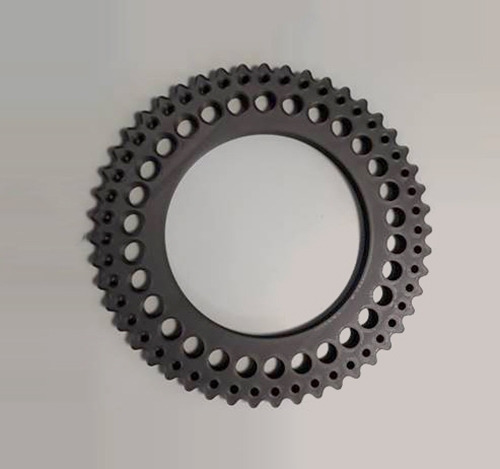In the first installment of this series, we looked at how 3D printing is being used in bicycles. In the second article, we went deeper and also examined 3D printing for e-bikes. On the whole, we concluded that many small players are using 3D printing to make polymer and metal bicycle components. Some of these are commercially viable and even successful.
One of the most fruitful could be the 3D printing of lugs. These unique lugs can be used in combination with regular tubing to make custom frame geometries. If we look into the near-future, custom, 3D printed carbon and 3D printed metal frames could become a reality.

A spoiler for a luxury car 3D printed and laminated with carbon fiber. Image courtesy of Caracol.
Given the fact that weight saving is so crucial in bikes, we can also expect a lot of weight-saving lightweight components. Usually a reduction in part count is also a good reason to use 3D printing, but this is more difficult to achieve in the case of bicycles. Different families of components are made with different suppliers, e.g., Selle Italia for seats, Reynolds for tubing, and Campagnolo for groupsets. At the same time, groupsets would need very high-quality 3D prints and finishing, leaving only powder bed fusion as a possibility, while other components such as seat stays could use less critical post-processing. Other components would be polymer or made to entirely different quality standards.
Broadly speaking, the above are listed as to how likely they are to happen, given how easy it would be for that instance to occur given the investment, place in the value chain, and dynamism of that player.
- Existing small players can continue to be innovative using bicycle components that differentiate.
- Other companies, such as Cinelli, are much smaller but could use technology’s cutting edge to remain competitive in Europe-based production through 3D printing. Since they already make components and bikes, it would let them develop new bicycles using 3D printing in an integrated way.
- Fizik and other components manufacturers could easily implement customized and mass customized premium offerings, as well.
- Canyon and Rose, as well as other web-only or direct-to-consumer brands, could integrate 3D printing in manufacturing to produce bikes quicker and make more components themselves.
- New players can use 3D printing to disrupt the existing market.
- Chinese suppliers could rely on China-made 3D printers to differentiate their offering and move up the value chain. Perhaps in some cases, they could build their own brands off the back of 3D printing.
- Specialized components suppliers, like Miche, can branch out into new products using small production runs and 3D printing.
- Companies could grow by bring out-of-production parts to market.
- Multi-brand companies, such as Accell and Pon Holdings, could differentiate across brands by implementing 3D printing.
- On the whole, some companies, including Giant, would be large enough to implement 3D printing across many quality fields, materials, and processes. Giant indeed is the largest manufacturer of bicycles making almost all types at all price points in different technologies in Taiwan. They also make components, a lot of frames, and entire bikes for many other players. They could adopt 3D printing wholesale to gain an advantage over upcoming Chinese suppliers.
- Companies such as Campagnolo or SRAM could use 3D printing to make high-end components using 3D printing that could outperform their competitors.
- 3D printing could become a buzzword for the entire industry and many players can take to it simultaneously as happened with carbon frames.
- A business could 3D print all of the components that make up a bike and completely disrupt the market.

A composite bell crank 3D printed with CBAM technology. Image courtesy of Impossible Objects.
The aforementioned is meant to be a general helicopter view of the market entry opportunities and opportunities for players in the bicycle market using 3D printing. As we have seen in orthopedics, hearing aids, and other markets that have fundamentally been disrupted by 3D printing, there are wholesale disruptions in the value chain. Aggressive, opportunistic, strategically acute, or cash-rich players have all leapfrogged their positions in the value chain via 3D printing.

3D printed workholding gear. Image courtesy of Markforged.
Generally what we’ve seen is that some companies realize the importance of 3D printing in creating components that are low-volume, high-performance, unique, weight-saving or quicker-to-market. In orthopedics, for example, Stryker has capitalized on the capabilities of 3D printing to make parts that have better bone adhesion because we can create the right surface texture to promote osseointegration. At the same time, through lattice structures and the like, we can more closely approximate the modulus of bone, which makes the implant less likely to cause issues, such as stress shearing.
We can also make a relatively low-volume production runs, allowing us to manufacture many different sizes and different implants in the same builds, with the same materials and the same processes. In the future, we could in the future also have individualized orthopedic implants that may make the fit better and lead to less blood loss and faster recovery. At the same time we can produce implants that are tough and wear-resistant enough to work as “structural” orthopedic implants.
And the cherry on top in orthopedics is that we are significantly cheaper than conventionally manufactured implants by a factor of ten. We can meet the required surface roughness, tolerances and production speeds, and prices as well. And perfection is important since faults in devices or in operations can cost thousands or millions. In this case 3D printing orthopedics is the best business case out there.
Another business case that is very good, but in a different way, is the 3D printing of rocket engines. For many of these parts, we can match the performance of cast and forged parts, while producing components within the tolerances and costs required. What’s more we can make more lightweight structures, optimize surface textures for ignition and flow, and reduce part count. Reducing part count means less money tied up in tooling and upfront cost, while we have significantly fewer production steps, which means that six sigma excellence is easier. Moreover, we can produce components, iterate, and go from drawing-to-part faster, as well.
Typically, here we’re looking at the potential of what I call 40/40/40/40/40. The five forties are:
- a potential reduction of part count by a factor of 40
- a reduction in mass of 40%
- a reduction of weight of 40%
- 40% less time to produce a part
- 40% less cost overall
The five forties have been achieved in a number of industries, but will not be achievable in all industries. Commoditization, size, and specific characteristics that are hard for us to achieve (smoothness, color) could make it impossible in some other fields. But, if we look at the relative importance of the five forties and the 11 scenarios for bikes, what do we expect to happen?
Subscribe to Our Email Newsletter
Stay up-to-date on all the latest news from the 3D printing industry and receive information and offers from third party vendors.
You May Also Like
3D Printing Financials: Fathom Struggles in Financial Quicksand During Critical Transition
Facing a year of key transitions and financial pressures, Fathom (Nasdaq: FTHM) has filed its annual report for 2023 with the U.S. Securities and Exchange Commission (SEC). The document outlines...
Latest Earnings Overview for Australian 3D Printing Firms Titomic and AML3D
Australian 3D printing manufacturing firms Titomic (ASX: TTT) and AML3D (ASX: AL3) reported their financial results for the period from July to December 2023, marking the first half of their...
3D Printing Webinar and Event Roundup: April 7, 2024
Webinars and events in the 3D printing industry are picking back up this week! Sea-Air-Space is coming to Maryland, and SAE International is sponsoring a 3D Systems webinar about 3D...
3D Printing Financials: Unpacking Farsoon and BLT’s 2023 Performance
In the Chinese 3D printing industry, two companies, Farsoon (SHA: 688433) and Bright Laser Technologies, or BLT (SHA: 688333), have recently unveiled their full-year earnings for 2023. Farsoon reported increases...































